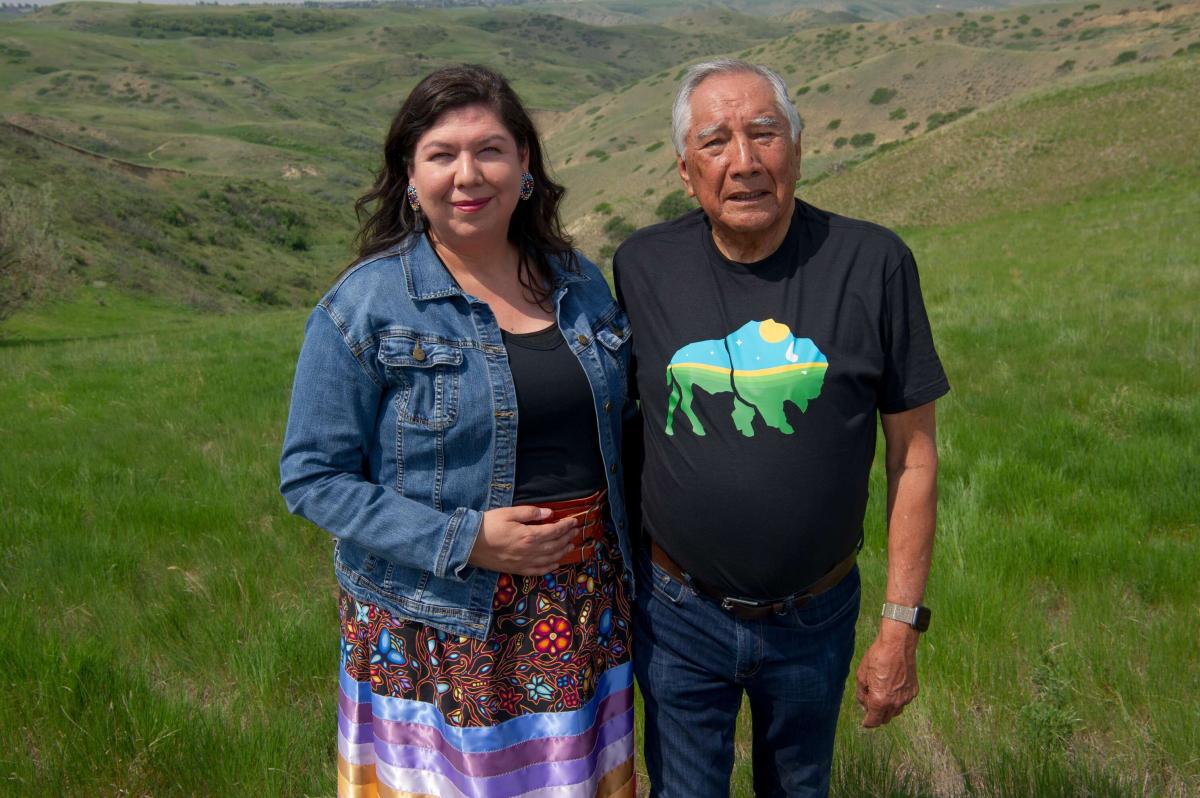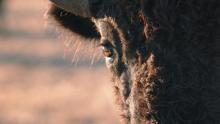Last week I attended a screening of Singing Back the Buffalo, written and directed by Tasha Hubbard, with my family at the Regina Public Library Film Theatre. The last time we’d seen buffalo together was in 2018 in Grasslands National Park. I wanted my kids to see the keystone species of our ecoregion. To know their presence on the land was good. Hubbard’s film was another opportunity to learn about the importance of buffalo from an Indigenous perspective.
Singing Back the Buffalo, screening in theatres across Canada this fall, documents a 10-year journey of buffalo “rematriation” by Indigenous people from First Nations and tribes in Canada and the U.S.
“Rematriation” means the restoration, often women-led, of Indigenous relationships to land, which are underpinned by an understanding of Earth as a sacred mother. In her film, Hubbard shares that the buffalo is “our relative, the one we learn from, the one that cares for us,” a nation that Indigenous people entered into deep relationship with for centuries.

As a child, I learned that buffalo on the North American Plains were hunted to near extinction in the 19th century, and that this area (Regina) was once called “oskana ka-asastēk,” by the Cree, translated to “Pile of Bones” by settlers. In university, I learned about the importance of the buffalo to the prairie ecosystem, its use in Indigenous ceremonies, and that its near extinction was caused by over-hunting by European settlers. But I was unaware of the nature of the relationship between this animal and First Nations.
It’s as if your grandma and grandpa stand next to you, says Dr. Leroy Little Bear, Blackfoot researcher and professor emeritus at the University of Lethbridge, in the film.
I was closest to my father’s mother, who raised my Dad and his siblings in Regina with her husband, who died before I was born. My grandma, Erika, was conceived in Russia and born in Manitoba. She lived on a farm near Whitewood. I’m not Mennonite (her maiden name was Mahler) but Erika worked hard on her farm, in her garden as an older woman, and I’ve always felt a kinship with her, though I’m still learning her story. My father would have been a rancher in another life; he still talks about working on a public pasture, rounding up cattle, as a young man. I’m a city kid, but I’ve inherited a posture of respect and awe towards this land I call home, which has been the home of the Cree, Saulteaux, Dakota, Nakota, Lakota and the Métis.
The film charts—literally, with beautiful animated maps—buffalo renewal projects in national parks in Canada (Elk Island and Banff), and on reserves in the U.S. (Blackfeet reservation in Montana, Rosebud reservation in South Dakota, Wind River reservation in Wyoming). Stories and teachings are shared by members of nations and tribes. Hubbard’s abundant footage of buffalo on plains, in forests, on mountainsides, in snow, on grass, returning to their traditional territories is a lovely act of resistance, of “transcending imposed boundaries.”
“I saw [the buffalo’s] pain,” said Kerry Benjoe, editor of Eaglefather News Media, who also attended the screening. Benjoe, a seasoned journalist who has covered Indigenous news over the years, told me the film is a “good story,” a “heart story,” which is needed for balance in Indigenous storytelling. “It was very powerful,” she said, noting the parallel between the disappearance of the buffalo and the restriction of Indigenous peoples’ movement across the plains, through the creation of reserves and in Canada, the pass system.
The film also highlights partnership of nations and tribes working together to bring buffalo back to their lands through the Buffalo Treaty, first signed in 2014 by eight nations and tribes. This week, the signatories to the treaty, which now number over 40, celebrated the treaty’s tenth anniversary in Stand Off, Alberta, co-hosted by Kainai First Nation, the Buffalo Women’s Society and the International Buffalo Relations Institute.
There were two moments in the film that my children couldn’t stop talking about after we left the theatre that night. I don’t want to spoil the film for anyone, so I’ll describe them somewhat generally. Both parts—one a story told by a man who experienced it on his reserve, the other shown through footage from a national park—involve buffalo physically drawing near to Indigenous peoples as they sing to them. Interactions with buffalo are described as “metaphysical” and “beyond our understanding.”
Thanks to Hubbard’s film, my family has a new respect and appreciation for a keystone species that has played a pivotal role on the prairies for millenia. The story of the Buffalo Treaty is an important one to learn as we live into being treaty people.
Find more about Singing Back the Buffalo at https://buffalosong.com/.





Add new comment
Canadian Mennonite invites comments and encourages constructive discussion about our content. Actual full names (first and last) are required. Comments are moderated and may be edited. They will not appear online until approved and will be posted during business hours. Some comments may be reproduced in print.